On The Record with Greg Lonzo, Claremont-Mudd-Scripps Men’s and Women’s Water Polo Coach
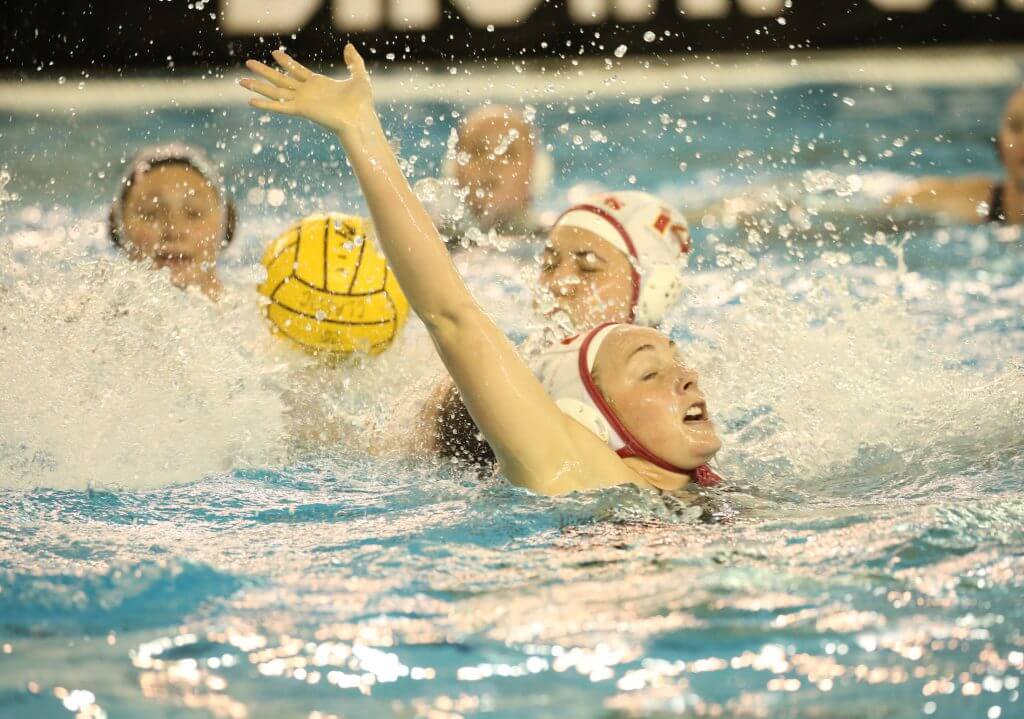
PROVIDENCE, RI. The 2020 Bruno Women’s Water Polo Classic last weekend was an opportunity to catch local teams in early season action at Brown’s Kathryn Graham Aquatics Center, one of East’s better facilities. Part of the tournament’s draw was participation by Whittier and Claremont-Mudd-Scripps, members of the Southern California Intercollegiate Athletic Conference (SCIAC). Both schools, along with Pomona-Pitzer, are among the nation’s best DIII programs, and contenders for the first-ever DIII Women’s Collegiate National Water Polo Championship, to be held May 8-9 in California.
[These Sharks Have Bite! LIU Wins First-Ever Match at 2020 Bruno Women’s Water Polo Classic]
 The reason for the CMS’s continued success is Greg Lonzo, head coach for the schools men’s and women’s programs the past 13 years. A 2002 graduate of Pepperdine, where he was among the school’s all-time leading scorers (175 goals), the California native has steered both the Stags and Athenas—as the schools men’s and women’s teams are known—to success. The Stags have won three SCIAC titles during Lonzo’s tenure, advancing to the NCAA men’s tournament in 2015. Last season, they were finalists for the inaugural men’s DIII championship match, dropping a 5-3 decision to host Whittier.
The reason for the CMS’s continued success is Greg Lonzo, head coach for the schools men’s and women’s programs the past 13 years. A 2002 graduate of Pepperdine, where he was among the school’s all-time leading scorers (175 goals), the California native has steered both the Stags and Athenas—as the schools men’s and women’s teams are known—to success. The Stags have won three SCIAC titles during Lonzo’s tenure, advancing to the NCAA men’s tournament in 2015. Last season, they were finalists for the inaugural men’s DIII championship match, dropping a 5-3 decision to host Whittier.
The Athenas have yet to win a SCIAC in Lonzo’s tenure, but the possibility of a national championship makes this year a prime target for a smart, strong and adaptive squad that plays the type of polo their coach excelled at as a player.
Swimming World spoke with Lonzo on the Graham pool deck about his decision to open his women’s season in the East, his time playing for Terry Schroeder at Pepperdine, the challenge of competing for players with more recognizable rivals and the impact of the new championship format in driving interest in men’s and women’s water polo.
– Why would a West Coast team open its season in the East?
It’s a bonding opportunity as a team early in the season when we’re trying to incorporate our new freshmen, our new players. It gives us a chance to get to know everybody really well, spend all that extra time with each other, and grow as a team.
And, we get the opportunity to play games against teams we don’t see on a usual basis. They’re different from us, so we have to make adjustments and play different styles. For us, that’s a lot of growth athletically; to be learning to play a different style within a game, and then having to adjust to the next team—a team that we’ve only watched play, and we’re trying to game plan for them. Whereas at home, we know those teams, we know what they’re bringing.
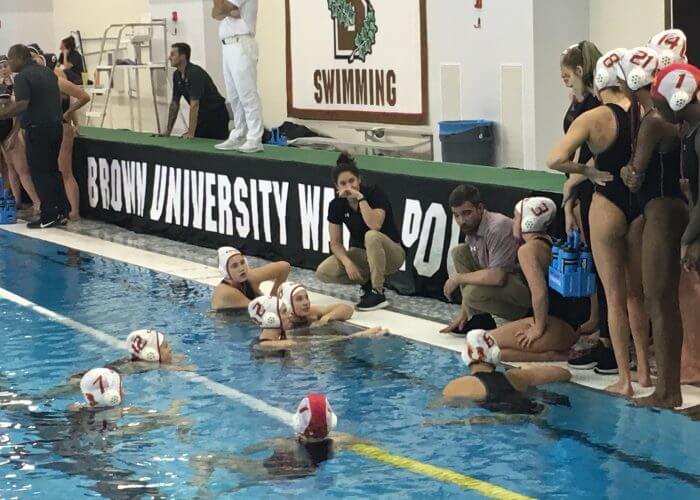
Lonzo talks to his players during play. Photo Courtesy: M. Randazzo
It allows our women to open up their field of vision [and] change the style that we play. In a month from now we’ll see where that return come, because we get to be a little more dynamic when we’re out here, we get to challenge them a little bit more, and do some things that we wouldn’t be doing at home right now.
– Another aspect of your travels: there’s a lot of talented high school water polo players in the region who might look to a CMS, or a Whittier, or a Pomona-Pitzer to play college ball.
Right. And that’s huge for us. For us the New England prep schools are a big piece to our college [recruitment]. The academics are right in line with what we look for. The personality is really aligned with our college as well. And the value of our education is seen by those families.
For us to get out here every couple years and make ourselves known is a huge piece to it. As much as getting out here and growing as a team this year it’s also marketing our team for the next years as that group of recruits comes through. They look at our schedule and say: ” You’ve been back East twice in three years.” If you’re from the East, your family can come see you play without having to travel across the country.
We were talking about division one teams coming out here. I think it’s great. The more we can spread high quality water polo [around] and make a presence of it—that helps the game to grow.
– As a subtext to this, a state like Pennsylvania—which has boys and girls state water polo championships—you’d like to think there are opportunities for PA polo athletes to continue playing in college.
Yes, 100%. Getting in front of those recruits is the most important piece. And again, coming out here for us is to get ourselves in front of those recruits, and show them we play a really high-quality style of water polo. We may be Division III, but we compete with some of the big Division I schools. So, there’s options, and we want to make sure that they know the option to come out to California is there for them.
The ability is there for them to grow as an athlete in four years with our teams. I think a lot of people look at DIII and think: “I’m really a student only.” But [our players] grow as we go through the season simply because we put so much effort into it.
And then at the end of the day, you get to be a real student in that fall semester.
– Your team plays a style of water polo that former Stanford coach Dante Dettamanti preaches; motion, strong swimmers, intelligent decision-making.
Right—and it’s developed over the years. We try to keep up with the Joneses in the sense of finding big body to get in the middle, but it’s just not something that suits our style, my style of coaching. Our athletes are very intelligent. So, for us to put them in a system that is slow and not thought provoking, it gets boring for them.
[Catching Up with Dante Dettamanti]
For us, it’s really challenging them, and putting them in situations like these—coming [East] here and kind of awkward situations. Different referees, different playing styles, different personalities. So, it makes them think about things.
As a coach, I like to play the style that I grew up playing. I like to coach that style, and that’s a fast pace, lots of movement. But also, intelligence. Think about things, see things before they happen, and try to process things quicker versus being analytical about everything. I think it’s helped us.
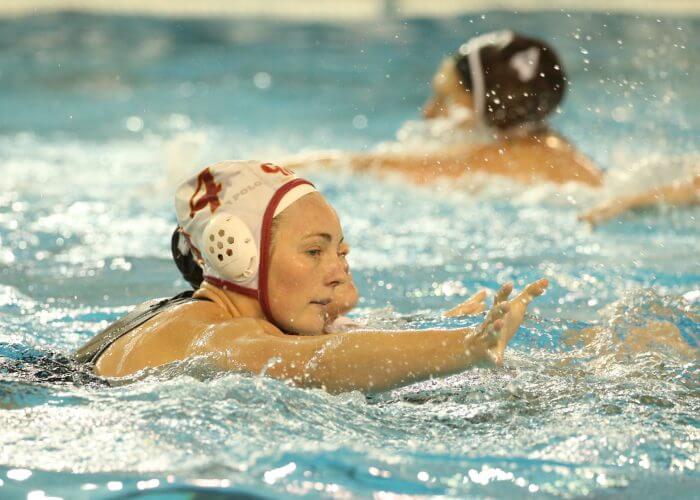
Aracelia Aldrete is one of the players that makes the Athenas go. Photo Courtesy: Patrick Hughes, Jr.
And again, within the recruiting piece, we have to find athletes that will work well with that. The biggest challenge is finding athletes that fit within our structure and style.
This weekend, I really saw with this team [that] we’ve done a great job finding those right type of athletes, and we’re getting to play the style of water polo that we want. It’s noticeably more aggressive, more intense, a lot of motion, a lot of activity.
My hope is that the game continues to evolve; in general, not just our team, but the game of water polo. Six people in a pool at a time; I want all six to do something. I don’t want to play around one person and sit still.
What it is the value of knowing that we don’t have to compete against DI teams, these are opportunities with training and getting better as a team, but we know that we have to focus on our conference. And to be good in our confidence you have to understand what’s going to be successful. And for us, it’s the speed, it’s playing quick, it’s playing a different style of water polo.
– In your polo career, you played for Pepperdine’s Terry Schroeder, the legendary American polo player and coach.
Terry’s incredible. He is a very approachable, very personable guy. And he’s somebody that once you build a relationship between the two of you, he trusts you. He does things that he knows is going to benefit the program, benefit the athlete. And he was always super supportive. Somebody that taught me a ton about how to manage relationships, and how to make sure your athletes believe in you, believe in your system, trust in what you’re doing.
Because that was something he was better than anybody I’ve ever met at building those relationships. But also at making you believe you are better than you were. And it was simply just the way that he spoke, the way that he presented himself. He always cared, he always was invested in you.
When you can get to that level, it makes your athletes strive to be better, to work harder for you and trust you more.
[From the Vault: Pepperdine’s Schroeder Talks NCAA Water Polo, 2016 US Olympic Men, MPSF & GCC Split]
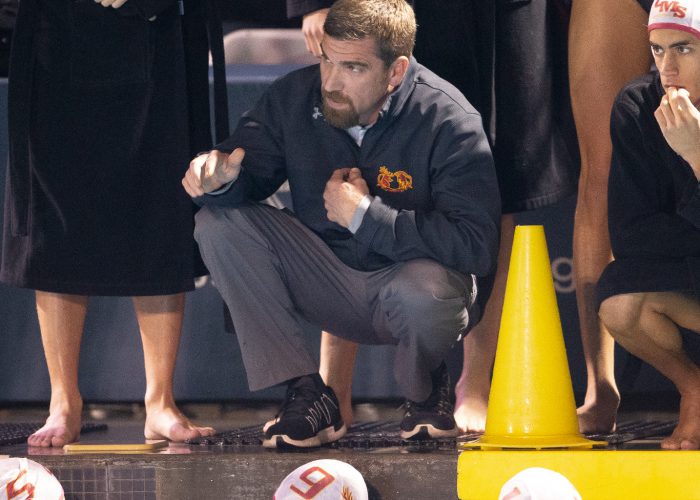
Lonzo coaching at the DIII men’s championship. Photo Courtesy: Tony Leon
Playing for Terry taught me so many lessons. And he also gave me so many great opportunities. I was not recruited as an athlete . From that point, it was working my way up. It was building that relationship. Getting him to trust me, and once he trusted me, it flourished.
I was able to do great things in my last three years there after my freshman year. But it was learning from him just how to manage situations, and how to manage a group of 20 people to have everybody on the same page, everybody working towards the same goal, and everybody focused on the same things.
When I was there, we were able to shift the way we played because of athletes like me. Smaller, faster, more aggressive. We were able to take away some of that center position, and play more motion. That was another thing I learned: you work with what you have. You can’t just force people to do what you want them. You have to understand your athletes, understand what they’re capable of, and build a structure and system around their talents.
It makes them believe more, it gives you a better experience as a coach. When you let them know: “We’re working to invest in your talents. We’re going to do everything we can to make you successful.”
– That style is not only the hallmark of your school, but DIII ball in general. Now, there’s a championship for your school your conference—the SCIAC—and all the great, small DIII programs.
I’ve already seen that with our men getting and opportunity to play in that tournament. Our women watched the whole process, and saw what they went through. Already, we’re further ahead now than we’ve been in the past, simply because the ladies know: “We got that carrot at the end of the stick.”
[SW Polo Roundtable With Jen Dubow, John Abdou & Dan Sharadin On Biggest Issues Facing The Sport]
The immediate piece is that it makes them more competitive, it makes them drive a lot more athletically, and see [the championship as a] focus point. I think the long end of it is you’re going to see a lot of athletes saying: “Hey, I could go play at a low end D1 school, or I could come to a SCIAC school,” and have the opportunity to play in a national championship, to be competitive in the big scheme of things.
– That’s the hope, and I think that’s an exciting possibility. But I go back to East Coast prospects—and their parents—who think it’s DI or bust.
Right. And in the recruiting process, it’s as much as letting the athlete know what we do, what we’re capable of, where we want to go, but it’s also letting the parents know the value of our school.
Water polo is great. They’re going to get a tremendous opportunity [at CMS]. They’re going to grow as an athlete. But we’re also going to provide them with the opportunity to do way more after four years. They’re going to put themselves in a situation where the rest of their life is an opportunity.
Once you get done with college, there’s not a whole lot going on after that for water polo. Our big sell, especially to families, is that you’re going to have an opportunity to be able to be successful in life, in your career and your family.
We’re holistic in everything we do. Water polo is an important piece, but you also have eight months where you’re not playing water polo, and I’m not coaching you. That’s the DIII setup, so in my experience, we have to have athletes that are self-motivated to be able to get in a pool and train all off season without me telling them what to do and how to do it.
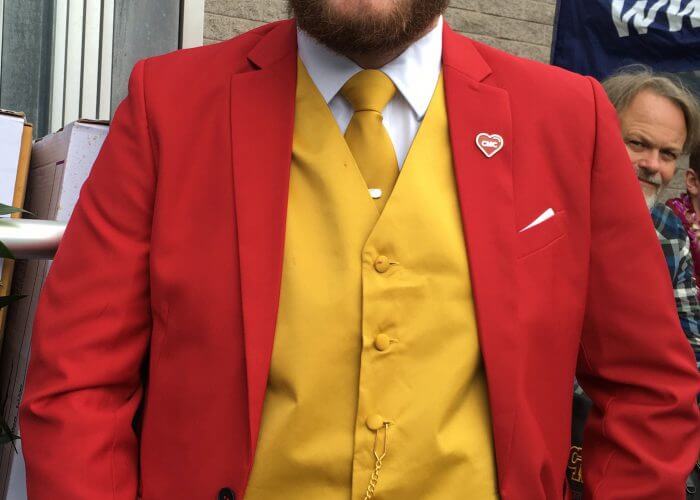
CMS is well-represented. Photo Courtesy: M. Randazzo
But also, those athletes that are going to be able to handle the rigors of the high academic level while we’re in season. All while we expect them to train and play like a Division I athlete.
– The previous few years Pomona-Pitzer was top dog in the SCIAC—but that now appears to be changing.
It’s an absolutely healthy trend. I don’t feel like it’s good to have the same team win every year. We need parity. We need to know that if you work hard and you bring in the right athletes, you’re going to be able to grow your program and be competitive. The brand name of the school, is a challenge … it’s Harvard or Princeton. You come out West [and it’s] Stanford or Pomona.
CMS is starting to put themselves on that national level. As coaches, it’s our job to get our name out there and market it. Again, coming out here to get our name out there just so people see like, “Oh, who’s CMS?”
They look it up and all of a sudden, they’re like, wow, academically they’re on par with Princeton, Harvard and Brown. We’re all looking at the same athletes, it’s just a matter of how do we get our name out there, and have people understand the quality of what we’re doing.
And I think that’s with all the other schools in the SCIAC. They have opportunities, and many things that are high quality about their programs. It’s just a matter of finding what your niche is—and finding the athlete that fits your niche.
Once you do that, as a coach, you now have athletes that fit you. And once you have athletes that fit you, it’s a lot easier to coach them, it’s a lot easier for them to buy in, it’s a lot easier to build those relationships and the trust piece.
There’s some players on my team that as seniors now it’s taken us two plus years to build that level of trust where no matter what I say, they believe it, they trust it, and they’ll go for it.



